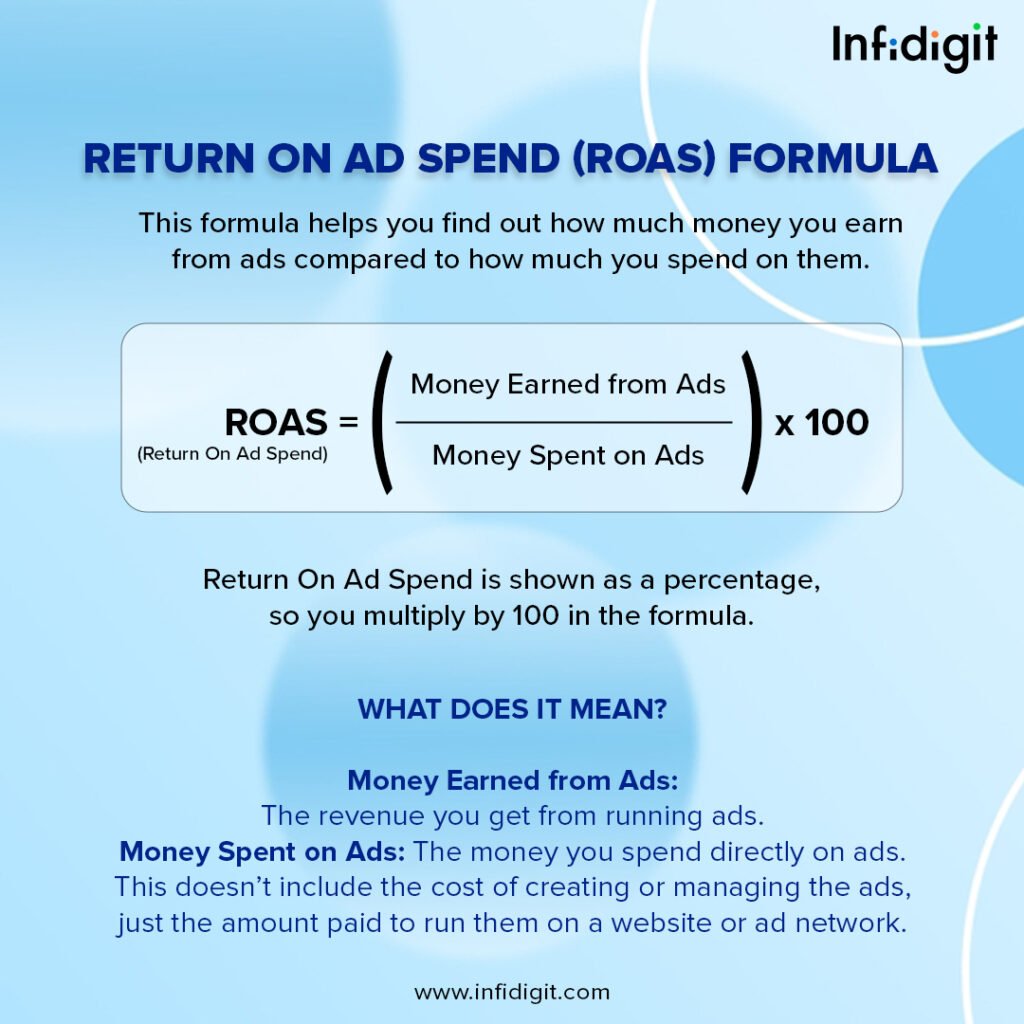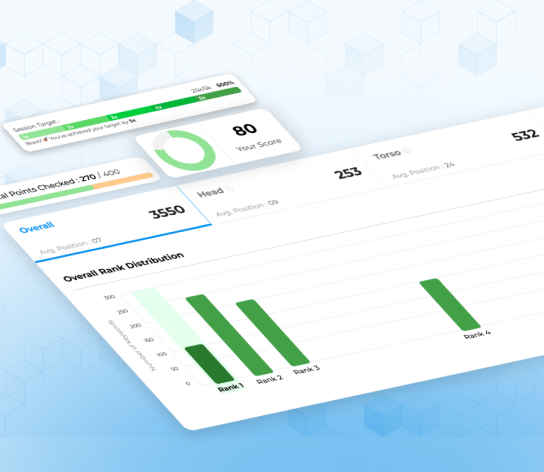Want better returns on every dollar?
SEO can help you with best ROI for your campaigns
What is a ROAS Calculator?
A ROAS calculator is a tool that helps businesses measure the effectiveness of their advertising campaigns by determining how much revenue they generate for every dollar spent on ads. Instead of manually analyzing data, this tool provides a quick and accurate way to understand how ROAS is calculated and make informed decisions to optimize ad performance. By using a ROAS calculator, businesses can efficiently track their returns and adjust their marketing strategies for better results.
What is ROAS (Return on Ad Spend)?
Return on Ad Spend, commonly referred to as ROAS, is a key metric used to measure the effectiveness of a digital advertising campaign. It calculates how much revenue is generated for every dollar spent on ads, helping businesses assess the profitability of their marketing efforts.
By using a ROAS calculator, marketers can simplify the ROAS calculation and gain a clearer understanding of their campaign’s financial performance. This metric plays a vital role in digital marketing, offering insights into how well ads drive sales and contribute to overall business growth.
How to Calculate ROAS?
Return on Ad Spend (ROAS) measures the revenue earned for every dollar spent on advertising. It helps businesses assess the effectiveness of their ad campaigns and make informed budget decisions.
ROAS Formula:
ROAS = Total Ad Revenue ÷ Total Ad Spend
ROAS Calculation Example
Let’s say a business spends $5,000 on an online advertising campaign and generates $20,000 in revenue from those ads.
Using the Return on Ad Spend formula:
ROAS = Total Ad Revenue ÷ Total Ad Spend
ROAS = $20,000 ÷ $5,000
ROAS = 4
This means the business earns $4 for every $1 spent on ads. A higher ROAS indicates a more profitable campaign, while a lower ROAS may suggest the need for strategy adjustments. Regularly tracking ROAS helps businesses optimize ad spending and improve overall marketing performance.
The Simple ROAS Calculation Formula Explained
Step-by-Step Guide to Calculate Your ROAS
Knowing how to calculate Return on Ad Spend (ROAS) is essential for measuring the effectiveness of your advertising efforts. ROAS helps businesses determine how much revenue is generated for every dollar spent on ads. By following a structured approach, you can accurately assess your ad performance and make data-driven decisions to optimize your campaigns.

Here’s a simple breakdown:
- Total Ad Revenue: Begin by tallying up the revenue generated exclusively from your advertising campaigns, including sales, leads, or any other conversion value directly attributed to your marketing efforts.
- Total Ad Spend: Determine the total cost you’ve incurred for those advertised campaigns. This isn’t just about the absolute figure but also about understanding your conversion cost to optimize spending.
- Divide and Calculate: Divide the total ad revenue by the total ad spend to obtain the ROAS value. Use the formula ROAS = Total Ad Revenue ÷ Total Ad Spend to compute your return. A Return on Ad Spend calculator can make this process quicker and more accurate.
- Interpret the Result: Analyze the ROAS figure to understand the effectiveness of your ad spend. A ROAS of 1 means you are breaking even, while higher numbers indicate profitability. Remember, a strong conversion rate boosts ROAS and signifies a successful spend conversion value.
The goal is to maintain a ROAS that aligns with your business objectives and profitability targets. By consistently evaluating your ad performance and adjusting your budget accordingly, you can maximize your returns and improve overall marketing efficiency.
How to Use the ROAS Calculator? (Infidigit’s ROAS Calculator)
Infidigit’s ROAS Calculator makes it easy to measure the effectiveness of your ad campaigns. Simply follow these steps:
- Enter Total Ad Revenue – Input the revenue generated from your advertising campaigns.
- Enter Total Ad Spend – Add the total amount spent on those ads.
- Get Instant ROAS Results – The calculator will automatically compute your ROAS, showing how much revenue you earn for every dollar spent.
Using this tool helps you quickly assess ad performance, optimize budget allocation, and improve your marketing strategy for better returns.
Why is ROAS Important for Marketers?
ROAS is a crucial metric that helps marketers evaluate the profitability of their advertising campaigns. It provides insights into whether ad spend is generating sufficient returns, enabling businesses to make data-driven decisions.
For e-commerce businesses, tracking ROAS is essential for optimizing ad performance and maximizing revenue. Using an eCommerce ROAS calculator simplifies this process, allowing marketers to assess their campaign efficiency and adjust strategies for better results. A strong ROAS indicates an effective campaign, while a low ROAS may signal the need for optimization.
What is a Good ROAS?
A good Return on Ad Spend (ROAS) varies across industries, but a common benchmark is 400%—meaning you earn $4 for every $1 spent on ads. However, ROAS isn’t just about percentages; the actual conversion value and business impact matter just as much.
An exceptional ROAS (800% or higher) indicates a highly efficient ad strategy, while a 100% ROAS (break-even) can still be beneficial if it helps cover essential costs like vendor fees and commissions. The key is to assess ROAS in the context of your business goals, conversion rates, and long-term profitability.
When setting ROAS targets, aim for a balance between ad spend efficiency and sustainable growth. A higher ROAS isn’t always better if it limits scalability or requires excessive resources to maintain. Instead, focus on optimizing ad performance while ensuring long-term profitability.
Factors That Influence ROAS
Several factors impact Return on Ad Spend (ROAS), affecting the profitability of your ad campaigns. Understanding these elements can help optimize performance and maximize returns.
- Ad Quality & Creatives – Engaging visuals and compelling copy boost conversions.
- Targeting & Audience Relevance – Reaching the right audience improves ad performance.
- Bidding Strategy & Ad Spend Efficiency – Smart bidding and budget optimization maximize returns.
Regularly analyzing these factors and making data-driven adjustments can improve campaign performance and boost overall ROAS.
Benefits of using a ROAS calculator
The competitive world of digital advertising can be daunting, but businesses that leverage the right tools often reap the rewards of strategic insights and improved profit margins. A Return on Ad Spend (ROAS) calculator is a tool, designed to refine advertising strategies and boost the efficiency of marketing budgets.
Informed Budget Allocation
With a marketing ROI calculator, you ensure that every dollar of your marketing budget is consciously spent. The data-driven tool helps detect which advertising campaigns yield the highest return on investment, crucial for campaigns where every advertising dollar counts.
Strategy Optimization
A ROAS calculator reveals which advertising channels and campaigns drive the most revenue, steering your strategy toward the most profitable platforms. By bolstering the effectiveness of your advertising techniques, a ROAS calculator can directly influence your conversion value and ad conversions.
Quantitative Success Evaluation
A ROAS calculator precisely measures campaign profitability. Implementing a sales conversion and conversion rate evaluation helps quantify the success of your marketing efforts, balancing the conversion cost against the actual revenue generated.
How to Improve Your ROAS?
Boosting Return on Ad Spend (ROAS) requires strategic optimization. Here’s how you can improve it:
- Enhance Ad Quality – Use compelling visuals and persuasive copy to increase engagement.
- Refine Targeting – Focus on the right audience to improve conversion rates.
- Optimize Bidding Strategy – Adjust bids based on performance to maximize returns.
- Improve Landing Pages – Ensure a seamless user experience to drive more conversions.
- Analyze and Adjust – Regularly track ROAS and refine your strategy for better results.
Consistently optimizing these elements helps maximize ad efficiency and profitability.
Frequently Asked Questions
1. Why is Calculating ROAS Essential for Marketers?
Calculating ROAS is essential for marketers as it directly reflects the effectiveness of advertising campaigns. With this metric, they can clearly understand which campaigns are driving revenue, and allocate the marketing budget accordingly to maximize profitability. Just like a conversion rate calculator, ROAS can serve as a comprehensive tool for data-driven decisions in budget allocation.
ROAS not only affirms the success of high-performing ads but also helps identify and improve or discontinue underperforming ones. By analyzing the conversion rate alongside ROAS, marketers can fine-tune their strategies, making informed decisions that enhance the campaign’s impact on the bottom line.
Understanding the ROAS range is crucial for marketing strategy optimization, as a marketing expert notes, “since it allows for precise measurement of the efficacy of advertising campaigns and understanding the conversion rate plays a big part in that equation.
2. How Can I Use the ROAS Calculator to Optimize My Campaigns?
You can use the ROAS Calculator to optimize your Google Ads campaigns through data-driven decision-making. First, assess the performance of various PPC campaigns to identify which ones yield the best ROAS, effectively maximizing each campaign’s conversion value. Utilize insights on conversion rate, conversion cost, and sales conversion to make informed adjustments.
Then, reallocate your budget towards those high-performing campaigns, ensuring you improve your cost per conversion. Additionally, use the calculator to test scenarios with different ad spends and revenues to forecast potential outcomes in your Google Ads.
This proactive approach allows you to tweak your strategies for better results. By consistently monitoring and adjusting where and how much you invest in advertising, you ensure continual improvement of your campaigns’ profitability, ultimately enhancing the conversion rate and lowering the conversion cost for better ROI.
3. How often should businesses calculate their ROAS?
Businesses should calculate their ROAS routinely, with the frequency depending on the nature and dynamics of their ad campaigns. For high-budget and fast-paced campaigns, assessing ROAS weekly or even daily is crucial to staying agile and making timely adjustments.
For less intensive advertising strategies, a monthly calculation may suffice. Regular analysis ensures that marketing strategies remain effective and align with financial objectives while allowing for real-time optimizations that capitalize on emerging trends or consumer behavior.
The calculator will then divide the revenue by the ad spend to determine your Return on Ad Spend (ROAS). For instance, if you spent $500 on ads with effective conversion cost management, and those ads resulted in a conversion rate that generated $1500 in revenue, your ROAS would be 3, or 300%, indicating not just a profitable ad campaign, but also that you’re likely exceeding your target ROAS.
It’s an essential tool for data-driven decision-making, enabling you to allocate your advertising budget more effectively and maximize the return on every dollar invested in your campaigns.
Free SEO Tools
How useful was this post?
5 / 5. 4








